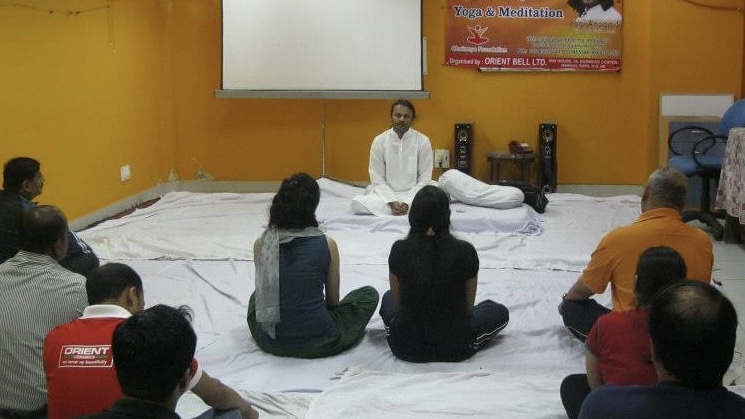
Philosophy:The Foundation of Mental Health
8 months ago By Yogi AnoopPhilosophy and Mental Health: Its Role in Disease Treatment
Philosophy is not merely limited to external observation; rather, it is the process through which the seer (soul) experiences its own existence. As long as the seer remains confined to observing the external world and desires satisfaction solely from it, self-realization does not occur. This happens because the seer cannot attain complete satisfaction within the limited scope of the external world. The external world itself is finite, and thus, it cannot provide absolute fulfillment to the seer. This dissatisfaction leads the seer into a state of unrest, causing mental distractions and ultimately contributing to physical illnesses.
However, in Indian philosophy, the term ‘darshan’ (philosophy) does not mean merely seeing external objects but refers to the realization of the seer itself. That is, when the seer does not remain engaged in experiencing the external world but instead turns inward to witness its own essence, it attains true realization. This self-realization resolves all doubts of life and simultaneously stabilizes the mind within itself. This state of mental stability allows the body and mind to heal themselves in the most profound way.
In my experiments, spiritual disorders only arise when one’s self-awareness is lost…
The Root Cause of Mental Illness
The primary cause of mental illness is that an individual becomes so engrossed in the external world that they forget themselves. The mind becomes entangled in external objects, and this entanglement disrupts the harmony of the mind, brain, and body. If an individual understands the true meaning of darshan, they can liberate themselves from these mental afflictions.
The Relationship Between ‘Darshan’ and Mental Disorders
When the seer remains confined only to external observation, it limits intellectual growth. In my experience, as intellectual capacity becomes restricted, so does the ability to think broadly. One must understand that limiting one’s perspective does not prevent mental stress. In other words, a narrow perspective does not allow for effective solutions to problems.
Additionally, it is crucial to realize that life cannot be lived meaningfully within a restricted viewpoint.
• If the seer entangles itself in external perceptions, it mistakenly believes that staying attached to them will provide complete satisfaction. However, this is not possible. As a result, the individual eventually falls victim to stress, anxiety, and depression.
• When the seer considers external objects as the sole foundation of life, the mind loses stability. This instability prevents the mind from calming its fluctuations, leading to suffering, distress, and illness.
• The primary cause of mental distress is that the seer generates such strong emotions for external objects that it becomes trapped in them and is unable to free itself. This is precisely why Patanjali’s Yoga Sutras define liberation from external objects as true stability. When mental fluctuations cease completely, self-realization, or the realization of one’s true nature, occurs. This self-realization is the ultimate state of being.
Self-Realization as a Solution to Mental Disorders
When the mental fluctuations are completely ceased, meaning the seer detaches itself from external objects, then “Tada drashtuh svarupe avasthanam”—that is, the seer abides in its true nature. With this self-realization and experience, complete health is attained. In this state, no symptoms of mental disorders remain. The individual even becomes free from all forms of psychological dependencies.
• Self-experience frees an individual from all mental illusions. This liberation from illusions fosters mental stability, which helps regulate serotonin, a crucial neurotransmitter in the brain and body. Stability naturally detaches one from emotional turmoil and generates an unwavering sense of contentment. This deep sense of satisfaction is everlasting. Consequently, individuals with this state of realization do not suffer from imbalances in brain chemicals and hormones.
• Additionally, when serotonin levels increase, the stress hormone cortisol naturally decreases.
The Relationship Between ‘Darshan’ and Quality Sleep
The experience of one’s true self is so profound that, in this state, the external world loses its significance. This stability of the seer is the fundamental basis of mental tranquility, which in turn significantly enhances sleep quality.
From a scientific perspective, serotonin plays a crucial role in increasing melatonin, a neurotransmitter responsible for sleep regulation.
This is why I disagree with those who advocate physical exhaustion as a means to induce sleep. In my view, sleep is not merely related to physical fatigue but is deeply connected to mental peace. When the seer frees itself from external distractions, mental conflicts dissolve, and sleep-related concerns naturally resolve.
I assert from personal experience that deep sleep signifies the complete disengagement of the mind from its entanglements. From an Ayurvedic perspective, deep sleep is one of the most effective remedies for severe mental disorders. Most individuals suffering from mental illnesses exhibit insomnia or poor sleep quality. However, as one detaches from external perceptions, the depth of mental relaxation increases, and sleep disorders naturally subside.
• Detachment of the seer from external objects equates to mental relaxation, and mental relaxation increases melatonin production. Enhanced melatonin levels support the body’s ability to heal itself naturally.
• The stability that deep sleep provides strengthens the nervous system, which not only enhances willpower but also resolves many physiological imbalances over time.
Philosophy in Indian Tradition
India has been home to numerous philosophical traditions, most of which ultimately advocate for the liberation of the seer from the seen. In my opinion, studying any philosophical school can be beneficial. However, based on my personal practice, Sankhya and Patanjali’s philosophy provide a complete system of understanding life’s deeper realities. These philosophies guide an individual toward self-realization and self-stabilization, which is the essence of true liberation.
This self-realization is the ultimate goal—Moksha. Practices such as meditation, yoga, pranayama, and asanas serve as powerful tools to achieve this realization and are invaluable in attaining mental and physical well-being.
Recent Blog
Copyright - by Yogi Anoop Academy
